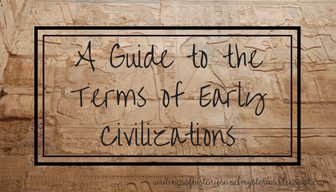A Guide to the Terms of Early Civilizations
Today’s article is continuing our study of World History. But before I began to discuss the actual civilization, I want to discuss the Fertile Crescent which is also called the “Cradle of Civilization.” This quick study in geography will bring us to the Plain of Shinar where Sumer, the first postdiluvian (post-Flood) civilization. If you haven’t read the previous historical articles to catch up. Also refer to the map of Mesopotamia for this article.
 |
The terms Mesopotamia, Cradle of Civilization, the Fertile Crescent, and the Plain of Shinar are easily confused and used interchangeably sometimes although that isn’t always the best option. Hopefully this post will smooth out any of the confusions of these terms.
Mesopotamia which is Greek for “between two rivers” is a broad description of where Sumer was located. Mesopotamia and the Fertile Crescent are not exactly the same geographic region. Mesopotamia not only refers to the land between the Tigris and Euphrates Rivers, but it can also include parts of the modern countries of Syria, Iraq, and Turkey. Mesopotamia included a scattering of different civilizations.
Mesopotamia is also called the “Cradle for Civilization” because the known world did begin in this region, and many world empires that still lend their influence today, began in this region. These are the civilizations and sometimes, empires that formed in this region in the order of their control: Sumer, Akkad, (Old) Babylon, Hattusa, Phoenicia, Israel (and Judah when the kingdom split), Assyria, Chaldea (or New Babylon), Media, and Persia. Some of these “kingdoms” held power at the same time as others. For example, Phoenicia controlled of the coastal trading along the upper coast of Africa and the coast of Israel. But they didn’t specifically control portions of land although they did have major cities such as Tyre. Israel also didn’t have an “empire,” although they did conquer some of the Canaanites in the area. One more note is that you may have heard of the Medo-Persian Empire. The reason the Medes and the Persians are split above is because the first rulers from the empire were Medes. Kings such as Darius were not Persian, but Medes. Cyrus the Great of Persia conquered the Medes in order to turn the empire over to the Persians. And of course, then the Greeks came. But before I get carried away, I will not delve into each kingdom in specific in this article.
In many articles that I have seen, the contributions of each individual Mesopotamian culture are attributed to Mesopotamia in general. Its culture influenced much of the early world mostly because of the kingdoms and empires that began in this area. I will not be discussing Mesopotamian culture in this article, but instead I will explain the culture through my article on Sumer and other cultures of this area.
I believe that the Fertile Crescent, on the other hand, is slightly different and larger. If you look at the map above, the Fertile Crescent not only includes all of the green area, but sometimes the Sinai Peninsula and more of Egypt is regarded as a part of this region. The Fertile Crescent is also said to be the location of the Garden of Eden, but it seems like a rather large area to me. According to the articles I have read, James Henry Breasted, an Egyptologist first used this term in his 1916 book Ancient Times: A History of the Early World.
This term is also used interchangeably with the “Cradle of Civilization.” If we were to use that term, we could include Egypt as one of the “civilizations” in the term. National Geographic stated in 2001, that according to satellite images only 10% of the Fertile Crescent remains. The United Nations Environmental Program was reported to be undertaking a restoration project as bodies of water and about forty species of “waterfowl” are also at risk of endangerment. They blame this problem as a result of excessive damming and draining of the bodies of water in the region. But that was in 2001, and the region may have benefited from the restoration since then.
The Plain of Shinar is also used as another term for Mesopotamia, but this is not correct according to the Bible. Genesis 10:8-10 says, “And Cush begat Nimrod: he began to be a mighty one in the earth. He was a mighty hunter before the Lord: wherefore it is said, Even as Nimrod the mighty hunter before the Lord. And the beginning of his kingdom was Babel, and Erech, and Accad, and Calneh, in the land of Shinar.” So far, we know that Shinar includes Babel (which is Babylon) and Akkad (Accad). Erech is the Sumerian city of Uruk which I will discuss in a later article. Scholar and archaeologist W. F. Albright hypothesized that the Calneh is actually a distortion of an expression meaning “all of them.” This may be so, but I don’t believe that the King James Version, which is from the original Greek, would have a grammatical error. But then again grammatical errors don’t change the veracity or accuracy of Scripture so it is a possibility.
But in verse 11 of Genesis 10, we are told, “Out of that land went forth Asshur, and builded Nineveh, and the city Rehoboth, and Calah.” That debunks the idea that the Plain of Shinar is Mesopotamia. Mesopotamia includes Assyria (whose capital is Nineveh), and Shinar does not. We don't know much about Shinar otherwise.
That was today’s article. In the coming months, I will write about Sumerian culture and continue our trek through world history. These articles actually take a lot of studying and researching and I learned many things as I wrote this article. Hopefully, I will also be able to write about prominent archaeologists who studied this area (like Agatha Christie, her husband, and her friends) as well.
I will close this article with a verse. 1 John 4:18 says, “There is no fear in love; but perfect love casteth out fear: because fear hath torment. He that feareth is not made perfect in love.” This is one of my favorite verses (or perhaps my favorite verse; I can’t decide; okay, it is) because it tells an important truth. If we trust that God loves us, we don’t have to fear anything; God will protect. If we are truly His children, He will always protect us. I first paid attention to this verse when it was quoted in Treasures in the Snow by Patricia St. John (which is a great Christian fiction book by the way). It has been a very encouraging verse for me throughout times when I was scared about the unknown, namely the future. I hope that this will encourage you, and that you will be able to read the Christian fiction books by Patricia St. John.




Comments
Post a Comment